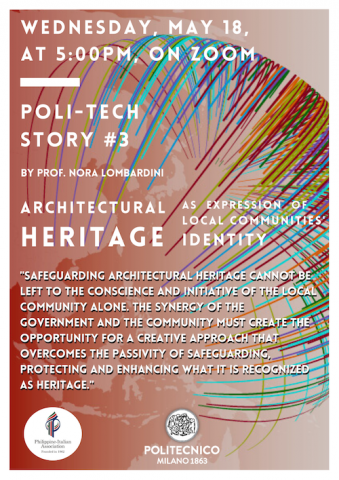The Philippine Italian Association has partnered with the Politecnico di Milano to bring to the Philippines the Poli-Tech Stories:
a series of encounters on Politech Culture with Professors and researchers of this prestigious university.
With them we will hear stories of Science, Technology, Creativity, Human and Professional Stories, and finally stories of our Future!
The Third Of These Encounters Will Be Virtual, On Zoom, On May 18, At 5:00 PM.

Architectural Heritage As Expression Of Local Communities’ Identity
The safeguarding of cultural heritage and, specifically, architectural heritage, as an expression of cultural identity, means the defense, as the 2011 Faro Convention argues, of human rights and is part of the concept of democracy. Therefore, there is a need for a collective participation in its protection and enhancement which concerns not only the governing bodies but also the communities that identify themselves in cultural heritage.
Governments have, in fact, the duty to interface with communities guaranteeing them the care of everything that can help to create “understanding, identity, cohesion and creativity” (Faro Convention, 2011).
It is evident that the extreme difficulty of implementing this process is answered by adopting all the most suitable tools for safeguarding the asset itself. The idea of protection is linked to the awareness that cultural heritage, and the architectural one, belongs to every people and this assertion assumes that it is not really the people, but are the guarantors government of the people who take charge of the protection of the goods which is awarded with universal value.
The connection between the government and the local community must create opportunities for heritage conservation. These opportunities are expressed through the understanding of the identity needs of individual communities, but also in the creation of opportunities for knowledge and work.
In fact, the conservation and transmission to the future of architectural heritage is grafted onto a production process that provides for the formation and creation of a specific labor market with technologies and specializations that, on the one hand, open up new opportunities. of work, on the other hand it accentuates the responsibility of the communities as a whole and in the singularity of its components.
Safeguarding architectural heritage, therefore, cannot be left to the conscience and initiative of the local community alone. The synergy of the government and the community itself must create the opportunity for a creative approach that overcomes the passivity of safeguarding, protecting and enhancing what it is recognized as heritage.
